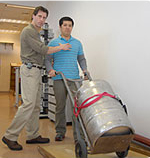
What was your journey in becoming an occupational therapist?
I was working in a metal foundry making parts for the military. I injured my hand, and my physician sent me to an occupational therapist for rehabilitation. This was my first exposure to occupational therapy. A year or so later I decided I needed a career change and remembered my therapy experience. I looked at the education requirements and the career opportunities as an occupational therapist assistant (OTA) and occupational therapist (OT). I took some coursework at Cleveland State University and then applied to their occupational therapy program.
As part of the program, we were required to spend six months, full-time doing clinicals. One of my two three-month clinicals was at Cleveland Clinic. I interned on the Inpatient Rehabilitation Unit and just loved it. It was so rewarding to work with patients and help them get better and stronger and more independent. Once I graduated with my bachelor’s degree in occupational therapy, I sought a full-time position at Cleveland Clinic. I chose to work here because of the hospital's the reputation, the wide variety of patients that I would see, the teaching and learning environments, and the large occupational therapy department with the mentoring and the wide range of experiences that I knew it would afford me.
Occupational therapists can work in many different settings and locations and still be a Cleveland Clinic employee. I know that if I need a change from my current work, I can continue to work for Cleveland Clinic, but just at a different location or with a different type of patient population. Also, the medical field is always growing and changing so there is always something new to learn.
I think people who are considering a career as an occupational therapist need to be active listeners, be able to work very well with all types of people and be able to read patients' nonverbal. I currently work in an outpatient setting doing “Return to Work Services” for injured workers. I enjoy working with a team of other medical professionals including physicians, nurses, vocational counselors, and physical therapists. I also enjoy watching patients get better and stronger so they can return to their jobs. My current position requires me to be very creative and the work is never the same from day to day. It is always exciting, challenging, and interesting.
Individuals interested in occupational therapy can go to school for an associate's degree and become an occupational therapist assistant (OTA) or earn a Master’s or Doctoral Degree and become an occupational therapist. (The minimum educational requirements for the occupational therapist have changed from a baccalaureate degree to a master’s degree.) Occupational therapist assistants work under the direction of an occupational therapist.
I will never forget one patient that I treated on the Inpatient Rehabilitation Unit. He had suffered a spinal cord injury from a bicycle accident. He had an amazing spirit and the heart of a lion, along with a great sense of humor despite his disability. We worked together daily on basic self-care skills like dressing, bathing, eating, and moving from his bed to a wheelchair. He worked so hard and stayed really positive throughout the process.
Learn More
- Meet an occupational therapist: Angela.
- Occupational therapy programs and occupational therapist assistant programs affiliated with Cleveland Clinic.
- Visit the occupational therapist profile and occupational therapist assistant profile for more about these career paths.